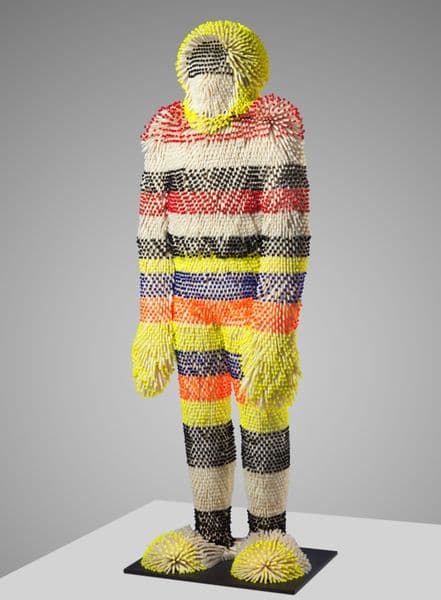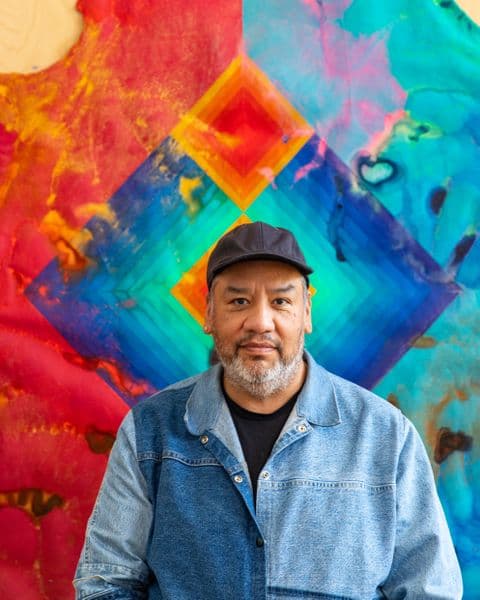Ten Questions with Jeffrey Gibson
///national-gallery-of-australia/media/dd/images/Jeffrey_Gibson_Photo_by_Brian_Barlow_1.jpg)
Jeffrey Gibson. Copyright Jeffrey Gibson. Courtesy the artist, Stephen Friedman Gallery, Sikkema Jenkins & Co., and Roberts Projects. Photo by Brian Barlow
The National Gallery has recently acquired Untitled figure 2, 2022, a major sculpture by JEFFREY GIBSON, a member of the Mississippi Band of Choctaw Indians and of Cherokee descent, who represented the United States at the 60th Venice Biennale. He reflects on the role of art and nature, how art can be a political tool and his constant questioning of value.
What was your first experience of art?
I remember making drawings for my parents and them being appreciative, complimenting me, and encouraging me to continue. My father used to bring small posters of artworks home from his business travels, which I would put on my bedroom walls. I distinctly recall having a few Matisse images taped up. And when my family would visit Oklahoma and Mississippi I would be introduced to the work of local Native artists and sometimes get postcards of their work in local gift shops. I would copy them and give those drawings to other family members.
What do you see as the function of art?
Art serves many purposes: it can offer an escape from the stressful realities of day-to-day life, and it can encourage hope and dreams of a better world in which one can feel free. Art is a form of nonverbal communication that can trigger the brain to see things differently and build confidence in using one’s entire body — not just one’s eyes, hands and voice — to navigate the world.
How is art a political tool?
Politics is embedded in almost everything around us because it is essentially about power dynamics, some of which we can control and some of which we cannot. Art is a tool to imagine other possibilities and give those possibilities form through movement, image, colour, sound and voice. Artworks can bring people together in a shared vision, both consciously and subconsciously. When we are united, we gain a collective power that can leverage agency in some of the relationships that seem beyond our control as individuals.
What inspires you?
I am truly inspired by the relationships that I see in nature, which includes our relationships to one another as people. One of the greatest human qualities is our ability to express love — for ourselves and for others. I am also intrigued by the absence of love in our society and world at large, which is so destructive on every level. Expressing love, receiving love and losing love are all very scary experiences.
What is the role of intuition in your work?
I have returned to a more intuitive way of working during the past few years. I believe that we all hold most of the information that we need to navigate the world. Our bodies are remarkable and are constantly trying to communicate the need for care to ourselves, but there are so many distractions that draw our attention away from listening to our bodies and our environments. Moving intuitively requires a great deal of listening; I have been working on that more intentionally lately.
Do you have an ideal audience in mind when you create your work?
My ideal audience is one that includes people from all backgrounds, all ages, all genders, in a wonderful mix. In the past decade I have craved seeing more Indigenous folks in the audience, and it is great to see that is happening, but I am always hoping to see more.
What important influences have shaped your approach to art making?
Having lived in other countries — in South Korea, Germany and in London — as a child and a young adult has had a tremendous influence on me. The experience of being a foreigner in another place is something I really appreciate. Music has also been a huge influence. Ever since I was a child, sound and colour have paired easily in my mind, and that is still very much the case today when I am working in the studio .
How important are music and dance to you?
Music and dance are hugely important to me. Music to me feels like something that cannot be contained: sound travels and literally bounces off surfaces. It makes things vibrate and has a palpable effect on our bodies on a cellular level. Dance is one of the most malleable forms of movement. You can do anything, sometimes to a beat but you can also move without any accompanying sound. Music and dance can generate a kind of hive energy that allows us to share our individual energies with one another. I hope everyone has the chance to experience that at some point in their lifetime — it is a magical experience.
What was the evolution of Untitled figure 2, 2022, which was recently acquired by the National Gallery?
I began to work figuratively using the materials that Indigenous dancers often make their dance regalia from but in quantities that are beyond practical. I see the garment as a kind of body that enables transformation, and that transformation enables the wearer to move differently in the world. For Untitled figure 2, I wanted to play with the bone pipe beads in large quantities and see what kinds of shapes could be made. The result is a bodily garment that makes sound when it moves, where the textures remind me of porcupine quills and some of the shapes look like sea anemones. Visually the figure seems to come from another world, but the familiar bone pipe connects it to something that many people have seen before, to a previous history.
Jeffrey Gibson was born in 1972, Colorado, USA. He currently lives and works in Hudson Valley, New York. His work fuses his Choctaw-Cherokee heritage and experience of living in Europe, Asia and the United States with references that span club culture, queer theory, fashion, politics, literature and art history.
Gibson represented the United States at the 60th Venice Biennale 2024, marking the first solo presentation of an Indigenous artist for the US Pavilion.
This story was first published in The Annual 2024.

